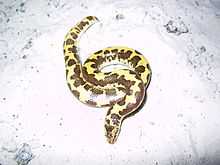Gongylophis colubrinus
| Gongylophis colubrinus | |
|---|---|
 | |
| Scientific classification | |
| Kingdom: | Animalia |
| Phylum: | Chordata |
| Subphylum: | Vertebrata |
| Class: | Reptilia |
| Order: | Squamata |
| Suborder: | Serpentes |
| Family: | Boidae |
| Subfamily: | Erycinae |
| Genus: | Gongylophis |
| Species: | G. colubrinus |
| Binomial name | |
| Gongylophis colubrinus (Linnaeus, 1758) | |
| Synonyms | |
| |
Gongylophis colubrinus, the Kenyan sand boa,[2] is a boa species found in northern Africa. No subspecies are currently recognized.[3]
Description
Adult specimens are rarely more than 91 cm (3 feet) in length.[2] These snakes are heavily built with small heads, small eyes, and short tails. The color pattern may consist of a yellow or orange coloration overlaid with dark brown splotches. The belly is white or cream colored.They are readily available in the pet trade due to their small size, docility and ease of care. In recent years there have been a number of new morphs made available by both commercial and hobby breeders. Some of the more popular morphs available include anerythristic Kenyan sand boas (black and white lacking orange/red simple recessive trait), albino Kenyan sand boas (lacking black pigment simple recessive), snow KSBs (double recessive combination of an anery and albino), stripes (normal colored, anerythristic, albino and snow), hypo/ghost anerythristic KSBs, paradox albinos (simple recessive), paradox snows (double recessive trait). In addition many line bred traits have been accentuated on the above morphs, such as Nuclears (extreme red), High Whites, Reduced Patterns as examples.
Common names
Egyptian sand boa, Kenyan sand boa, East African sand boa, sand boa.
Geographic range
Found in northern Africa from Egypt as far west as Niger (Aïr), including Somalia, Ethiopia, Sudan, Kenya, and northern Tanzania. A single specimen has been reported from Yemen. The type locality given is "Ægypto"[1]
Habitat
Occurs in semi-desert and scrub savannahs and rock outcroppings. Prefers sandy, friable soil.[2]
Behavior
During the hotter times of the year, they seek refuge beneath stones and in the burrows of small mammals.[2]
Feeding
These snakes spend most of their time in shallow burrows with only their head exposed. They feed on small mammals that are quickly seized when passing within striking range and killed by constriction.[2]
Reproduction
Viviparous, they breed readily November through April in the United States delivering live birth averaging 10-20 babies born spring through late summer.[4] The young at birth typically are 20–25 cm (8-10 inches) in length.[2]
Taxonomy
A synonym for this species is Eryx colubrinus, given by Linnaeus.[5] A.F. Stimson (1969) recognized two subspecies: Eryx colubrinus colubrinus and E. c. loveridgei Stull,[6] but mentioned that a number of other authors, including Loveridge (1936), Scortecci (1939), Parker (1949) and Ahl (1933), questioned whether E. c. loveridgei was valid and considered the species to be monotypic with geographic variation.[1]
When recognized, Gongylophis loveridgei is said to occur in the southern part of the range[2] and is described as being more orange in color. Due to the length of time this species has been captive bred in the United States it is now difficult to determine their taxon solely by color due to cross breeding.
See also
- List of erycine species and subspecies.
- Erycinae by common name
- Erycinae by taxonomic synonyms
References
- ↑ 1.0 1.1 1.2 McDiarmid RW, Campbell JA, Touré T. 1999. Snake Species of the World: A Taxonomic and Geographic Reference, vol. 1. Herpetologists' League. 511 pp. ISBN 1-893777-00-6 (series). ISBN 1-893777-01-4 (volume).
- ↑ 2.0 2.1 2.2 2.3 2.4 2.5 2.6 Mehrtens JM. 1987. Living Snakes of the World in Color. New York: Sterling Publishers. 480 pp. ISBN 0-8069-6460-X.
- ↑ "Gongylophis colubrinus". Integrated Taxonomic Information System. Retrieved 23 November 2007.
- ↑ Huntley, Mark. 2012. SandBoaMorph.com’s East African Sand Boa Care Guide, CreateSpace Publishing. 36 pp. ISBN 1481003429. ISBN 978-1481003421
- ↑ Linnaeus, C. 1758. Systema naturæ per regna tria naturæ, secundum classes, ordines, genera, species, cum characteribus, differentiis, synonymis, locis. Tomus I. Editio decima, reformata. Laurentii Salvii, Holmiæ. 10th Edition: 824 pp.
- ↑ Stull, O.G. 1932. Five new subspecies of the family Boidae. Occ. Pap. Boston Soc. nat. Hist. 8: 25-29
External links
| Wikimedia Commons has media related to Gongylophis colubrinus. |
- Gongylophis colubrinus at the Reptarium.cz Reptile Database. Accessed 23 November 2007.